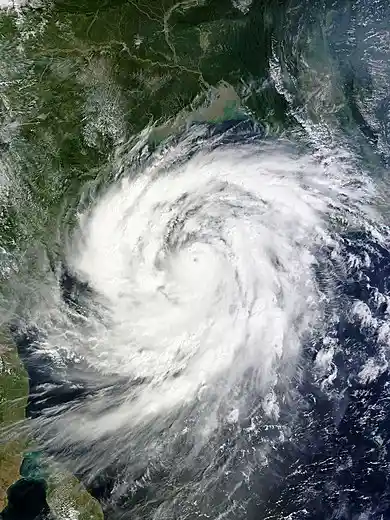The deadliest cyclone of the century
"Even with all our technology and the inventions that make modern life so much easier than it once was, it takes just one big natural disaster to wipe all that away and remind us that, here on Earth, we're still at the mercy of nature." Here is the story of cyclone Phailin, the super cyclone that broke hell in Odhisa.

Phailin, the extremely severe super cyclonic storm. Image Source: Wikipedia
It was a day when a single miscalculation led to one of the worst disasters in the country. A fatal mistake that completely shattered Odhisa. On 29 October 1999 cyclone Phailin hit Odhisa which came to be recorded as one of the deadliest cyclones of the century. People in midst of this monster only had hope because they knew no one was coming for them. After Phailin subsided even the hope was lost and Odhisa completely went silent.
It was a normal day for the state government officials. They got the reading on a storm brewing at low pressure over the Gulf of Siam on 24 October, however, in the next 36 hours the speed of this storm went to 260 Kph. It was much faster than a normal cyclone. Nevertheless, they weren't worried, the chances of it crossing Odhisa or any Indian territory for that matter were nil to low. It's probably the unpredictability of nature that makes it more menacing. What humans have spent years trying to build can be brought down within seconds.
There was nothing short of unusual at Paradip that day. People knew of the storm that might be coming but mostly when a cyclone grazed their path it brought at most heavy rainfalls. No one expected it to create havoc. But why weren't there any warning signals before Phailin was coming their way at such an enormous speed? As it turns out the speed of the cyclone far exceeded the average capacity. It was so high that the anemometer installed at Bhubaneswar and Paradip could not record it.
With the eye of the storm at Paradip, at 10:30 am, Phailin hit Odhisa. Whatever plan the government had gone right out of the window for this was no normal cyclone. Going at the speed of 260 kph, Phailin was classified as a super cyclone, an extremely severe category 5 tropical storm. It was calculated that the storm surge (the tsunami waves) caused by Phailin would be around 1.5m to 2m, but what was witnessed was a 10m storm surge. The hapless government could do nothing but watch as the cyclone tore Odhisa apart.
Like falling dominos, Odhisa was losing power and connection as Phailin ravaged its way through the state. The chief minister, Giridhar Gamang at his bungalow was profusely trying to work the phones to get all aid he could muster. Time was running out. Most cyclones vent their fury under eight hours of their landfall but this cyclone even after 10 hours was still going strong. It was snapping power and communication lines like twigs. At 9 pm two phones remained working at CM Gamang's home. By 11 pm it was only one. At midnight the final communication line went dead. The entire area had lost communication with the outside world. Odhisa was off the grid and the people in the midst of the storm were on their own.
Warnings about the storm did go off 2 days before the cyclone made landfall. But people weren't ready to part with their belongings and also there simply weren't enough cyclone shelters in Odhisa at that point. There were 21 shelters that could accommodate up to 2000 people. The result? The death toll was so enormous that bodies had to be bulldozed to graves. Many went unrecognized. Almost 10,000 people and 2 lakh cattle lost their lives. 3.5 lakh houses were completely blown away and destroyed as if nothing ever existed there.
The storm lasted for over 24 hours and the aftereffects lasted for days in the form of extremely heavy rainfall. People who made it were exhausted, most of them hopeless, after the loss of their loved ones and belongings. More than 7000 children were orphaned.
Help in the form of urgently needed funds and relief material finally started coming in, first from the Centre and later from governments across the world.
The super cyclone of 1999 still sends shivers down the spine of the people of Odhisa. After the tragedy, Odisha has worked immensely on cyclone shelters, practised evacuations, educated the people on the proceedings to follow during a storm hit. It was a lesson to be learnt from. It is always better to be prepared cause once the storms hit not much can be done. In fact, no creating by man has ever been made that could have contained the fury of the super cyclone, Phailin.

Cyclones of Odhisa. Image source: Utkal Today


